by Mary Salinas | Dec 4, 2015
The cooler weather in the wintertime makes it a great time to plant trees and shrubs. That is why Arbor Day in Florida is the third Friday in January. In 2016, that event is January 15.
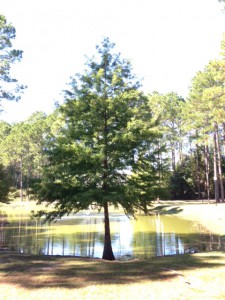
Baldcypress growing at the edge of a pond. Photo: Julie McConnell, UF/IFAS
Start your planning now with doing a site assessment on your landscape, then choosing the right trees and shrubs for your particular environmental conditions.
Here are some great sites that offer online tools for finding just the right species:
Florida Tree Selector
The Florida-friendly Guide to Plant Selection & Landscape Design
Florida Native Plant Society Locator
And if you want to find out just how much your established trees are worth, use this National Tree Benefit Calculator!
For more information:
Planting Trees in the Landscape
Arbor Day Foundation: Florida
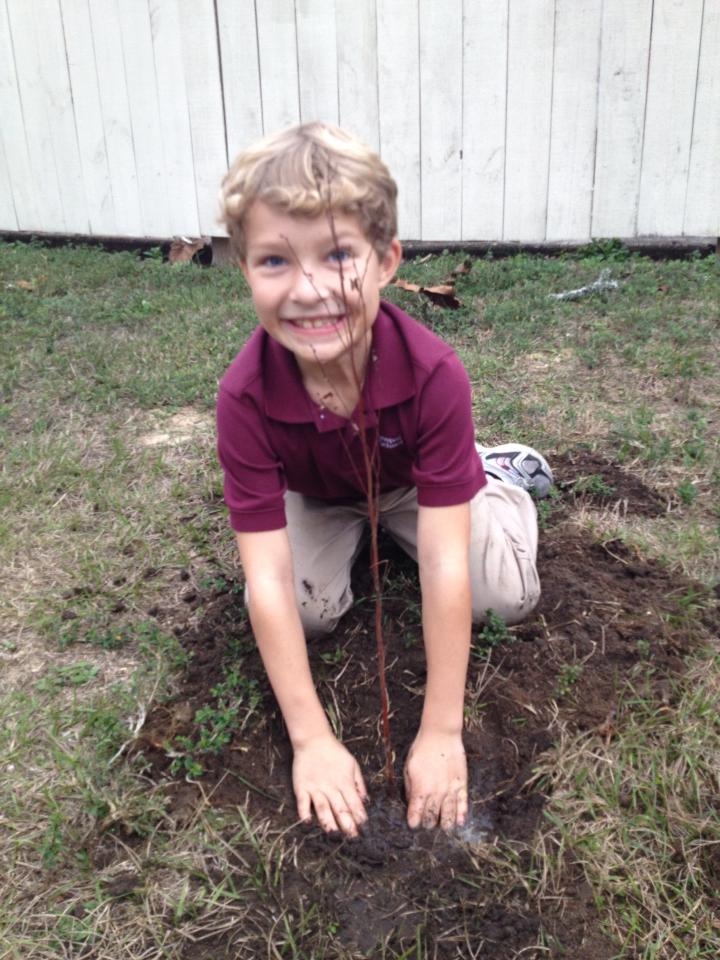
by Carrie Stevenson | Jan 13, 2015
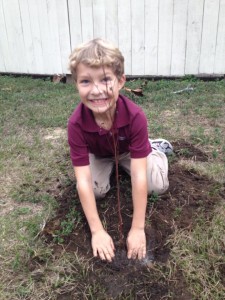
Planting a tree is an excellent way to insure clean air and water in the future. Photo credit: Carrie Stevenson
Most of us begin a new year with resolutions–to exercise more, to eat right, to spend our time more productively–but few things have as many lasting impacts for the future as the simple act of planting a tree.
Arbor Day (which literally means, “Tree Day”) was founded in 1872 by J. Sterling Morton, a naturalist and journalist in Nebraska. By 1882, it was celebrated by thousands of schoolchildren nationwide, who planted trees and took care of them with their classmates. Today, millions of communities and schools celebrate Arbor Day all over the world. Trees provide endless benefits, including shade, recreation, food and building products, shade and wind protection, wildlife habitat, oxygen production and carbon dioxide uptake.
Arbor Day is typically celebrated in the United States on the last Friday of April, but as ideal tree-planting conditions differ by climate, each state has its own specific Arbor Day, as well. Winter is the ideal time to plant trees in Florida, because it allows roots to develop without expending energy on growing new leaves and shoots. Our state celebration this year is January 16th.
Many local communities in Florida hold special events around this time. Be sure to check with your local Extension office or Native Plant Society chapter to find out if they are offering free trees or public events this month. For more information on the best trees for your area, be sure to take the time to read “Native Trees for North Florida” or peruse the UF Environmental Horticulture web page.
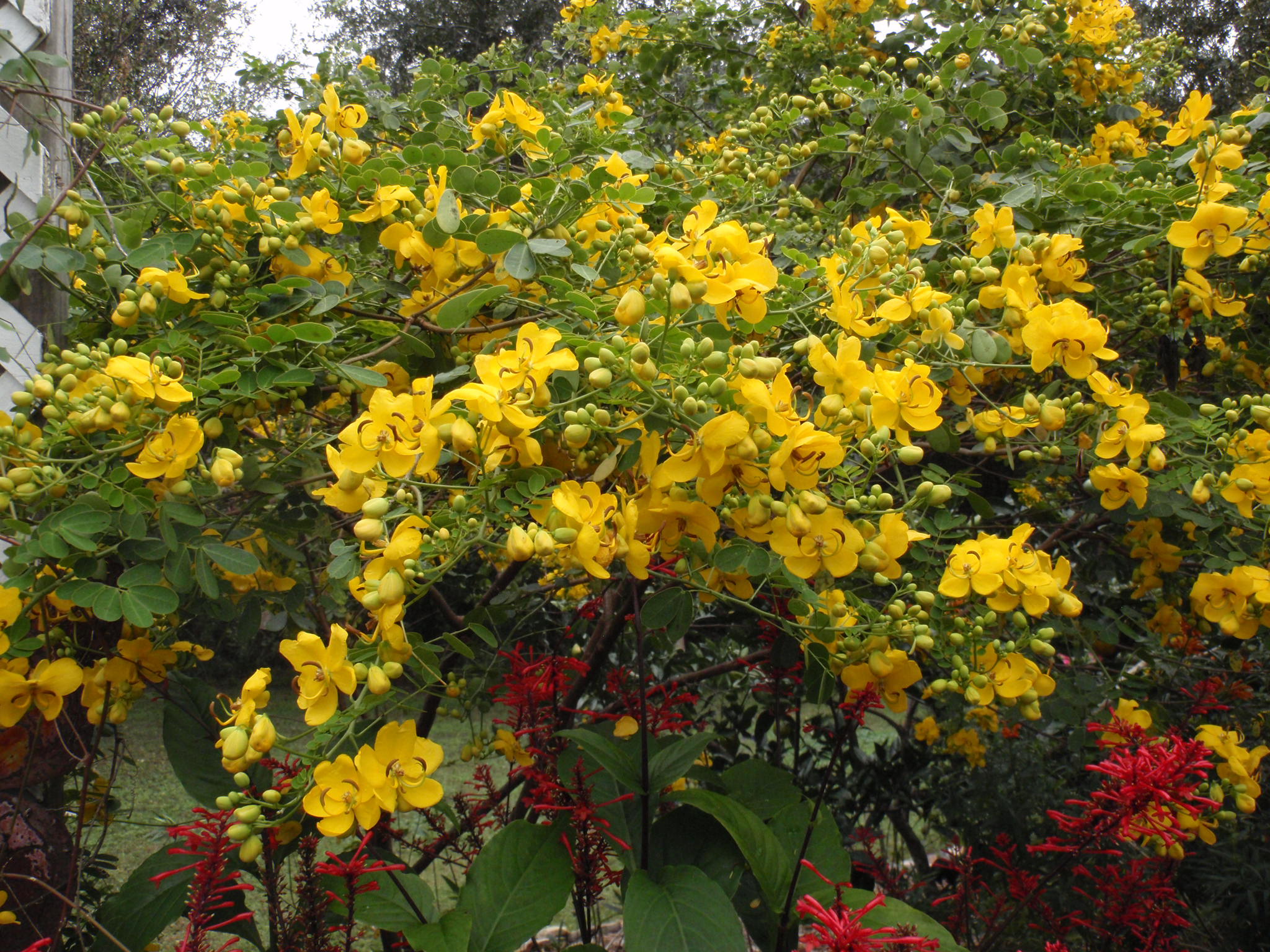
by Beth Bolles | Jan 14, 2014
Trees and shrubs often serve a distinct purpose in landscapes, other than to provide color. They are planted to provide shade, screen a view or noise, or to soften the hardscapes of the home.
With a little planning, we can have both beauty and function from trees and shrubs. Add a few trees and shrubs that have color in different seasons and your landscape will always be interesting.
The added benefit of growing trees and shrubs is that they are low maintenance. Once the plants are established in the landscape, they will require very little water and only an occasional application of a slow release fertilizer. A good layer of an organic mulch around the plants will help conserve moisture, prevent weeds, and keep root temperatures regulated during our temperature extremes. You may have to do a little pruning every year to remove any diseased, damaged, or severely crossing branches.
Here is a list of plants to give you garden interest throughout all seasons:
Winter color
- Taiwan cherry (Prunus campanulata) is an underutilized ornamental cherry for the coastal south. Clusters of dark pink flowers cover the plant which grows about 20 feet.
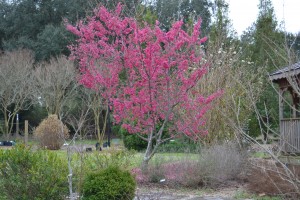
Taiwan cherry
- Camellia japonica is widely used in landscapes, but still an excellent choice for winter color. Careful selection of types will provide a garden with color from November through April.
- Red maple (Acer rubrum) will provide color in both the late winter and fall. Flowers are brilliant red in late winter and leaves begin turning red in late October.
- Other choices include Oakleaf hydrangea, Florida anise, Red buckeye, and Japanese magnolia
Spring
- Fringe tree (Chionanthus virginicus) can be in shrub or tree form and range in height from 10 – 20 feet. Forms white clusters of showy fringe-like flowers in late winter and early spring before the leaves emerge.
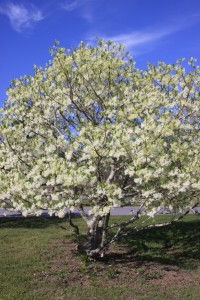
Fringe tree
- Chinese fringe (Lorepetalum chinesis ‘Rubrum’) is a very popular shrub. Pink blooms are heaviest in the spring. The plants can get up to 12 feet in height so plant it were it will not obstruct a view.
- Virginia sweetspire (Itea virginica) forms clusters of white flowers. Plants offer purplish foliage in the fall.
- Other choices include Banana shrub, native azaleas, Indian hawthorn, and Deutizia,
Summer
- Chaste tree (Vitex agnus castus) is a large shrub with fragrant leaves and spikes of purple flowers. Tolerates drought and develops interesting shape.
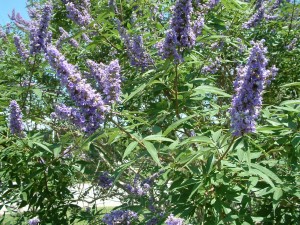
Chaste tree
- Loblolly bay (Gordonia lasianthus) is an evergreen tree that grows to 25-35 ft in height. Large white flowers with yellow stamens resemble camellia blooms.
- Abelia spp has white flowers that appear over the entire plant. It is attractive to butterflies .
- Other choices include Crape myrtle, Althea, Confederate rose, and Oleander
Fall
- Bald cypress (Taxodium distichum) will become a large tree over time. In the fall the feathery leaves will turn orange-brown. Good tree for both wet and dry areas.
- Beautyberry (Callicarpa americana) a native that forms clusters of purple berries that line the stem. Leaves turn yellow and provide fall interest as well.
- Cassia bicapsularis can reach 8-12 ft in height and will have bright yellow flowers that form in October and persist until a freeze.
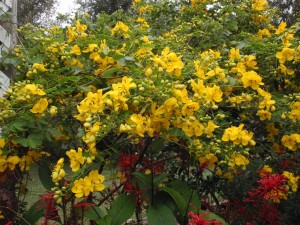
Cassia
by Mary Salinas | Dec 24, 2013
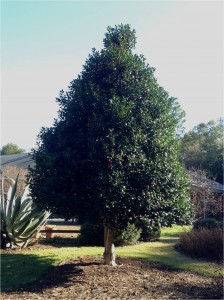
East Bay Holly. Photo by Mary Derrick, UF IFAS
[important]The best time to plant a tree was 20 years ago. The next best time is now. ~Chinese Proverb[/important]
In Florida, Arbor Day is always celebrated on the third Friday of January. In 2014, Arbor Day falls on Friday, January 17.
Consider planting a tree to enhance your property. Trees provide many benefits such as:
- Shade for leisure activities
- Lower energy costs for cooling
- Cover and food for wildlife
- Screen from unsightly views
- Privacy from neighbors
- Addition of value to your property; click here to determine the monetary value of a tree
If you have plenty of trees already, consider getting involved in a local community group that is sponsoring Arbor Day tree plantings. Or maybe your local church, park, non-profit or school would appreciate the donation and planting of a new tree.
So what trees are best to choose for the Florida panhandle? Some things to consider are soil type and pH, light, and any overhead obstructions. Click here for a publication that discusses what to consider when choosing a tree. Florida Trees for the Urban and Suburban Landscape will help you choose a particular tree species for your site. Considerations in tree selection may include bloom color and season, mature size, hurricane resistance, and whether it is evergreen or deciduous.
Once you have chosen a great tree for your specific site, proper installation and care is crucial to the success of your new tree. Click here to learn all about planting and caring for your tree.
For more information please see:
Arbor Day Foundation: Florida
Native Trees for North Florida
Palms for North Florida
Planting Trees in Landscapes
National Tree Benefit Calculator
by Sheila Dunning | Dec 17, 2013
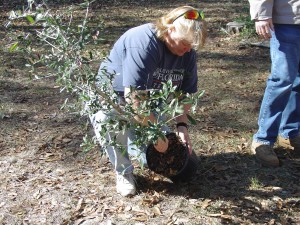
Removal of the container and inspection of the rootball is critical to tree survival.
The best time to plant a tree is twenty years ago. The second best time is Arbor Day 2014. Florida recognizes the event on the third Friday in January, so the next one is January 17, 2014.
Arbor Day is an annual observance that celebrates the role of trees in our lives and promotes tree planting and care. As a formal holiday, it was first observed on April 10, 1872 in the state of Nebraska. Today, every state and many countries join in the recognition of trees impact on people and the environment.
Trees are the longest living organisms on the planet and one of the earth’s greatest natural resources. They keep our air supply clean, reduce noise pollution, improve water quality, help prevent erosion, provide food and building materials, create shade, and help make our landscapes look beautiful. A single tree produces approximately 260 pounds of oxygen per year. That means two mature trees can supply enough oxygen annually to support a family of four.
The idea for Arbor Day in the U.S. began with Julius Sterling Morton. In 1854 he moved from Detroit to the area that is now the state of Nebraska. J. Sterling Morton was a journalist and nature lover who noticed that there were virtually no trees in Nebraska. He wrote and spoke about environmental stewardship and encouraged everyone to plant trees. Morton emphasized that trees were needed to act as windbreaks, to stabilize the soil, to provide shade, as well as, fuel and building materials for the early pioneers to prosper in the developing state.
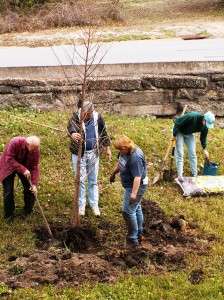
Proper planting depth and adequate watering can ensure long-term survival.
In 1872, The State Board of Agriculture accepted a resolution by J. Sterling Morton “to set aside one day to plant trees, both forest and fruit.” On April 10, 1872 one million trees were planted in Nebraska in honor of the first Arbor Day. Shortly after the 1872 observance, several other states passed legislation to observe Arbor Day. By 1920, 45 states and territories celebrated Arbor Day. Richard Nixon proclaimed the last Friday in April as National Arbor Day during his presidency in 1970.
Today, all 50 states in the U.S. have official Arbor Day, usually at a time of year that has the correct climatological conditions for planting trees. For Florida, the ideal tree planting time is January, so Florida’s Arbor Day is celebrated on the third Friday of the month. Similar events are observed throughout the world. In Israel it is the Tu B Shevat (New Year for Trees) on January 16, 2014. Germany has Tag des Baumes on April 25. Japan and Korea celebrate an entire week in April. Even, Iceland one of the treeless countries in the world observes Student’s Afforestation Day.
The trees planted on Arbor Day show a concern for future generations. The simple act of planting a tree represents a belief that the tree will grow and some day provide wood products, wildlife habitat erosion control, shelter from wind and sun, beauty, and inspiration for ourselves and our children.

Clayton ( Sheila’s grandson) will reap the benefits of the trees planted this Arbor Day.
“It is well that you should celebrate your Arbor Day thoughtfully, for within your lifetime the nation’s need of trees will become serious. We of an older generation can get along with what we have, though with growing hardship; but in your full manhood and womanhood you will want what nature once so bountifully supplied and man so thoughtlessly destroyed; and because of that want you will reproach us, not for what we have used, but for what we have wasted.”
~Theodore Roosevelt, 1907 Arbor Day Message
by Carrie Stevenson | Dec 9, 2013
How much is a 400-year old live oak tree worth? Can you buy one online, with free shipping, and charge it to the credit card? Pick one up at the local home improvement store? Ask Santa? Of course not. When admiring a tree that size, we have an innate sense of its value, but we would often have a hard time expressing it in dollars. How about a cluster of trees in a wooded lot? Are they worth more than the dollar store being built there? We are conditioned to appreciate the value of things because there’s a price tag on them. Unfortunately, natural phenomena do not have price tags, and many things that are “free” are often perceived to have no real value.
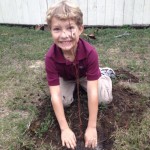
Planting a tree is an excellent way to insure clean air and water in the future. Photo credit: Carrie Stevenson
Trees, however, have value far beyond the price one might pay at a plant nursery. Their roots absorb polluted storm-water runoff, the primary cause of decreased water quality in Florida. Their leaves take in carbon dioxide and release the very oxygen we breathe. Providing homes for wildlife, fruit and nuts for human and animal consumption, compounds that form the basis of countless medications—trees provide innumerable benefits to ecosystems both local and worldwide. If a local government were to construct a facility or method that could filter the air and water at the same efficiency and volume of the trees in ones county, it would cost the community millions.
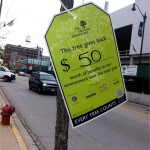
This street tree in Chicago was given a price tag to raise awareness of its value. Photo credit: Eric Stevenson
But how is is possible to capture these benefits in a way that we can relate to? Luckily, a partnership between arborists, engineers, and researchers with private industry, the US Forest Service, and the USDA has resulted in an excellent online tool called the National Tree Benefits calculator. Based on software called “i-Tree,” the calculator allows anyone to enter their zip code, choose from a list of common tree species, and using the diameter of a single tree, calculate its economic value. For example, a 15-inch live oak tree at the Escambia Extension office provides an annual benefit of $79 every year, increasing in value as it grows in girth and height. The website delves deeper into the tree’s value, placing storm-water uptake value at $23.77, electricity savings at $15.23, and the capability to remove 607 pounds of carbon dioxide from the atmosphere.
Extension Agents are currently working with youth in Escambia County to calculate these values for trees on their school campuses, local parks, and yards. When we’re finished, we will hang actual price tags on the trees showing their annual economic value to showcase these facts to residents of the community.
Interested in what kind of economic benefit that magnolia in the front yard is giving you? Check it out yourself at www.treebenefits.com, and let your neighbors know how valuable those trees can really be.














